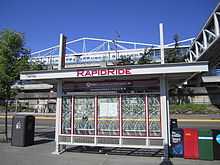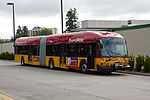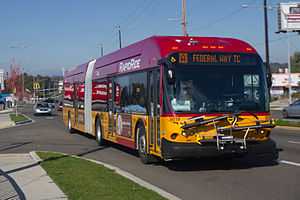RapidRide
|
RapidRide bus running on the A Line | |
| Founded | 2010 |
| Headquarters | Seattle, Washington |
| Locale | King County |
| Routes |
A Line: Tukwila - Federal Way |
| Fleet |
113 buses:[1]
|
| Fuel type | Diesel-electric Hybrid |
| Operator | King County Metro |
| Website | RapidRide |
RapidRide is a network of limited-stop bus routes with some bus rapid transit features in King County, Washington. The network consists of six corridors totaling 64 miles.[2] The system is operated by King County Metro Transit and funded by Transit Now. The first line began service in October 2010.[3]
RapidRide lines are faster than normal bus routes because they service fewer stops (40% less than the routes they replaced[4]), make extensive use of transit signal priority to preempt traffic lights and on some lines, use semi-exclusive lanes to bypass traffic.[5] RapidRide runs no less than every 10 minutes during peak commuting hours, every 15 minutes on weekends and during most off-peak hours and most lines (except the B and F lines) have late night and early morning service.[5]
The 6 RapidRide lines carry riders on nearly 53,500 trips per day, comprising about 15 percent of Metro’s total daily ridership.[6]
Lines
- A Line (opened October 2, 2010): Tukwila - Federal Way
- B Line (opened October 1, 2011): Redmond - Overlake - Bellevue
- C Line (opened September 29, 2012): West Seattle - Downtown Seattle
- D Line (opened September 29, 2012): Ballard - Uptown - Downtown Seattle
- E Line (opened February 15, 2014): Shoreline - Downtown Seattle
- F Line (opened June 7, 2014): Burien - Southcenter - Renton
Stations and stops

Stops are farther apart than typical Metro service to increase speed and reliability[5] and create "stations",[5] more akin to what is found on light rail lines. The stations look different from normal bus stops and have "tech pylons" that feature ORCA card readers for off-board fare payment, real time information signs[5][7] and automated voice announcements to communicate estimated arrival times of RapidRide buses. To increase security, stations are lit[7] and patrolled by transit police. Because of the frequent headways, riders do not have to wait as long at stations as they do at normal bus stops.
Equipment
RapidRide uses new, low-floor,[8] three door articulated buses that are painted with an identifiable look (a red and rellow livery) distinct from the buses used on other Metro routes.[5]
Passengers who have a valid transfer or who tap their ORCA Card at a validator (located at most "station" stops) can board any of the 3 doors on the bus.[8][9] Fares are enforced by spot checks by Metro's transit police or contracted fare inspectors.[4] Coaches feature racks for 3 bikes, Wi-Fi,[7] and security cameras.[4] RapidRide buses have fewer seats than similar articulated buses in Metro's fleet, allowing for more room for standing riders, which increases the total amount of passengers the bus can carry.
Coaches were the first to feature on-board automated announcements and signage that inform riders of the next available stop as the vehicle approaches. Metro has deployed the same technology to all vehicles.[7]
In 2010, New Flyer discontinued the "Advanced BRT" styling (DE60LFA) that was purchased for the coaches running the A Line. Later coaches were ordered with New Flyer's "Restyled" package (DE60LFR) and include one passive restraint for wheelchair users.[10]
Fleet Roster
| Builder | Model | Image | Engine/Transmission | Propulsion | Year | Fleet Series/(Qty.) |
|---|---|---|---|---|---|---|
| New Flyer | DE60LFA |  |
diesel-electric hybrid (parallel) | 2009-2010 | 6000-6019 (20) | |
| New Flyer | DE60LFR | |
|
diesel-electric hybrid (parallel) | 2011 | 6020-6035 (16) |
| New Flyer | DE60LFR | |
|
diesel-electric hybrid (parallel) | 2012 | 6040-6073 (34) |
| New Flyer | DE60LFR | |
|
diesel-electric hybrid (parallel) | 2013 | 6075-6117 (43) |
References
- ↑ "King County celebrates launch of new RapidRide F Line". King County Metro. 6 June 2014. Retrieved 10 June 2014.
- ↑ "Developing the Next Frontier: Capitalizing on Bus Rapid Transit to Build Community" (PDF). Urban Land Institute Northwest. 2012. Retrieved 2012-09-30.
- ↑ Viriyincy, Oran (2010-04-22). "RapidRide Information Board". Retrieved 2010-04-22.
- ↑ 4.0 4.1 4.2 "RapidRide Transit Design and Implementation" (PPT). 2008-11-12. Retrieved 2009-05-26.
- ↑ 5.0 5.1 5.2 5.3 5.4 5.5 "RapidRide". King County Metro Transit. Retrieved 2009-03-30.
- ↑ King County Executive's Office (30 July 2014). "Ridership for Metro's RapidRide surges again, up nearly 40 percent". http://kingcounty.gov/exec/news/release/2014/July/30_rapidride-results.aspx''.
- ↑ 7.0 7.1 7.2 7.3 "Oct. 1: Metro’s new RapidRide "A" Line to connect Tukwila and Federal Way launches Oct. 2". 2010-10-01. Retrieved 2011-02-02.
- ↑ 8.0 8.1 "Pacific Highway South RapidRide". King County Metro Transit. 2007-10-09. Retrieved 2009-03-30.
- ↑ "(Untitled)". Flickr user Citywalker. 2009-05-04. Retrieved 2009-05-06.
- ↑ "What’s different about the B Line buses? « RapidRide Blog". 2011-07-28. Retrieved 2011-07-28.
External links
| Wikimedia Commons has media related to RapidRide. |
- Official RapidRide website
- Details about planned RapidRide service
- RapidRide Blog
- Metro Transit
- Central Puget Sound Regional Fare Coordination
- Prototype bus photo sets on Flickr
| ||||||||||||||||||||||||||||||||||||||
